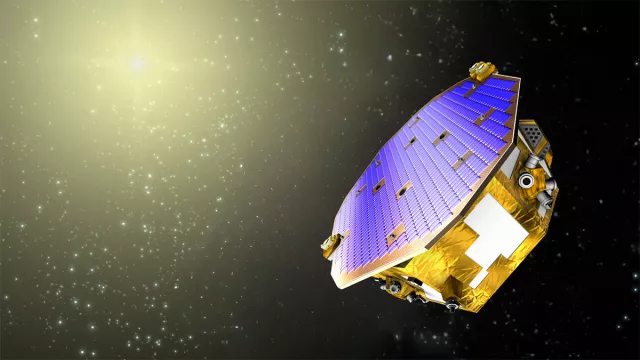On 3 December 2015, the LISA Pathfinder satellite was launched from Kourou en route to the Sun-Earth L1 Lagrange point. Its mission: to test technologies able to directly detect the gravitational waves predicted by Albert Einstein.
Key information
Key figures
- 1,900 kg: satellite mass
- 2 instruments
- 2.9 x 2.1 m: satellite dimensions
- 0.01 nanometres: measurement accuracy
Key milestones
- 18 July 2017: End of mission and deactivation of satellite
- 30 June 2017: End of science operations
- April 2016: Experiment confirms feasibility of LISA mission
- 1 March 2016: Scientific test starts
- 22 January 2016: Arrival at L1 Lagrange point
- 3 December 2015: LISA Pathfinder launched by Vega
Project in brief
The European Space Agency (ESA) is pursuing an ambitious physics mission focused on the gravitational universe (L3 mission) that aims to directly observe gravitational waves—the tiny ripples in the fabric of space-time predicted by Einstein’s theory of general relativity—using three satellites forming a giant optical interferometer. The presence of these waves will be signalled by minute relative movements between two test masses in free fall at the end of each of the interferometer’s arms.
LISA Pathfinder is a scaled-down model of an arm of the LISA interferometer packed into a single satellite that tested key technologies required to place the two test masses in perfect free-fall conditions and measure their relative movement with unprecedented precision. LISA Pathfinder also drew on the very latest developments to minimize other forces acting on the masses housed inside the LTP instrument (LISA Technology Package) and to measure their movement. With its inertial sensors, laser metrology, drag-free control and ultra-precise micro-propulsion systems, it was a truly ground-breaking mission.
CNES’s role
CNES and its partners in the French consortium coordinated by the APC astro-particles and cosmology laboratory were involved in this ESA-led mission for which they supplied a subsystem of the LTP instrument’s optical bench. They also performed operational science data analysis.
Contacts
Fundamental Physics subject matter expert
Martin Boutelier
E-mail: martin.boutelier at cnes.fr


